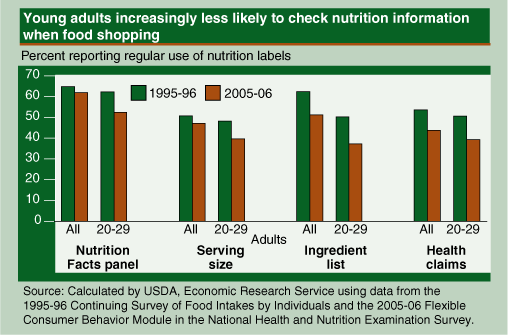Use of Nutrition Labels Declining, Especially Among Young Adults
- by Jessica E. Todd
- 9/1/2008
For more than 10 years, Americans have had access to standardized nutrition information on almost all packaged foods. The current format of the Nutrition Facts panel was introduced in 1994, following the Nutrition Labeling and Education Act (NLEA) of 1990. In addition, Federal regulators placed strict requirements on the content and wording of health claims made on food packages.
In creating standards for the presentation and content of nutritional information, NLEA made it easier for consumers to make more healthful food choices. Prior to NLEA, approximately 70 percent of adults reported using nutrition labels when making food purchases. A 1995-96 survey found no increase in label use, but consumers did report that the new labels made it easier to make more healthful food choices.
According to recent ERS analyses, label use is lower today than in 1995. After controlling for changes in population demographics, label use when food shopping dropped from 65 percent in 1995 to 62 percent in 2005. The decline in use of health claims was larger: 44 percent in 2005 versus 54 percent in 1995. For those who reported using labels, the proportion that referenced information about calories declined from 76 percent in 1995 to 68.5 percent in 2005, while use of fiber information increased slightly.
The decline in label use was greater among adults 20 to 29 years old than among other groups of U.S. consumers. Use of the Nutrition Facts panel by this group fell from 62 percent in 1995 to 52 percent in 2005, three times the decline observed among all adults. The decrease in use of information on calories, fat, cholesterol, and sodium was also greater among young adults than among all adults.
Today’s young adults may use nutrition labels less than their predecessors because they were not exposed to the informational campaigns that introduced the new labels. Alternatively, since young adults eat out more often than others, their benefits of label use may be lower since restaurants are not required to provide nutrition information. Moreover, nutritional information is currently available from other sources, such as the Internet, which young adults may be more likely to access than older consumers. More generally, other information on food labels, such as country of origin, production methods, and trade practices, may compete with nutrition information for consumers’ attention during their limited shopping time.
This article is drawn from:
- Todd, J.E. & Variyam, J. (2008). The Decline in Consumer Use of Food Nutrition Labels, 1995-2006. U.S. Department of Agriculture, Economic Research Service. ERR-63.


